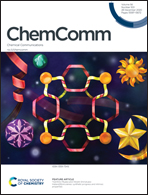Highly branched and defect-rich PdP nanosheets for ethanol oxidation electrocatalysis†
Abstract
Highly branched PdP nanosheets (NSs) rich in defects and with a thickness of ∼3.2 nm were synthesized, for the first time, via a nanoconfined attachment growth mechanism inside assembled lamellar micelles. Owing to the synergistic structural (being a highly branched, ultrathin, and defect-rich material) and compositional (P-alloyed) advantages, the PdP NSs exhibited remarkable electrocatalytic activity (3.2 A mgPd−1), a low reaction activation energy (16.0 kJ mol−1), good CO anti-poisoning ability, and electrocatalytic stability during the ethanol oxidation reaction (EOR) in alkaline conditions.



 Please wait while we load your content...
Please wait while we load your content...